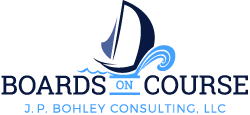Tip #80 What's an Annual Board Agenda Plan and How Can It Be Helpful?
Once it is recognized that the board’s job of governing the organization is different from the CEO’s job of managing the organization, an annual board agenda plan becomes an effective means for the board to be focused on its own role and to be proactive in its governance leadership.
The following steps can be taken by the board to develop and use its annual board agenda plan:
1. Be clear about your board’s role/job description (and how this is different from management’s role). (For example, the Policy Governance® board has three main job products that it is responsible for and it cannot delegate these to management: a) an ongoing linkage with key stakeholders on whose behalf it governs and to whom it is accountable), 2) written board policies that define its expectations for management and for itself, and 3) assurance of organizational performance in accordance with board expectations. The board may add other board job products if its wishes. (e.g., supportive legislative environment, funds raised for the organization, etc.)
2. Develop a list of routine tasks related to your board’s role/job description and when they need to be accomplished each year and plug these into your annual board agenda plan (for example, annual evaluation of the CEO, schedule for monitoring CEO compliance with board expectations as these are expressed in different board policies, schedule for the board’s monitoring of its own performance as these are expressed in different board policies).
3. Develop a list of non-routine objectives to be achieved in the upcoming year relative to the various components of your board role/job description and plug tasks related to these into the annual board meeting agenda plan for the coming year (for example, meetings with key stakeholder groups, target dates for particular board policies to be reviewed or developed, target date for a board special project such as a fundraising plan, etc.).
4. Throughout the year, prior to each individual board meeting, develop an agenda for that board meeting using the annual board agenda plan as a resource.
Hence, the annual board agenda plan identifies what board tasks are to be completed during or in preparation for board action at what particular board meetings. Such a plan may be formatted something like the following example of an annual board agenda plan for a board that meets six times a year:
Community Agency
Annual Board Agenda Plan
January – December 202X
| Board Meetings | Board Job Areas | |||||
| Seeking Community Input | Board Education |
Ends/Results |
Monitoring CEO Performance |
Board Self-Monitoring
|
Other | |
| January |
Demographic Trends |
Customer Treatment | Community Input | |||
| March | Community Survey | Treatment of Staff | Code of Conduct | |||
| May | Community Needs | Financial Performance | Relationship with CEO | |||
| July | Focus Groups | Ends/Results Achieved | Governance Style | Fundraising Plan | ||
| September | Futurist Presentation | Annual CEO Evaluation | The Board's Job | |||
| November | Update Ends Policy | Asset Protection | Board Committees | Agenda for Next Year | ||
Notes: The table above is meant as an illustration and is not intended to be comprehensive. In addition, some areas of CEO performance monitoring or board self-monitoring may be scheduled over a two or three year period. Finally, in Policy Governance®, monitoring organizational performance is seen as the same as monitoring CEO performance since the CEO is seen as responsible for organizational performance.
To learn more about the Policy Governance® model, please click https://www.BoardsOnCourse.com/policy-governance.
